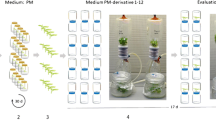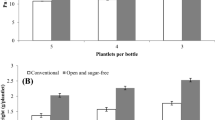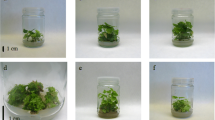Abstract
The objective of this study was to set up a plant micropropagation facility to mass propagate sugarcane, energy cane, and related clonally propagated species. An efficient methodology for micropropagation of energy cane and perennial grasses using temporary immersion bioreactors was developed. Several different methods of tissue culture initiation, multiplication, and rooting were evaluated for several varieties of sugarcane (Saccharum officinarum L.) and sugarcane-related species such as Erianthus spp., Miscanthus spp., and Sorghum spp. × sugarcane hybrids, all from a germplasm collection. Apical meristem cultures were initiated for all genotypes that were micropropagated, when liquid or semisolid Murashige and Skoog (MS) medium was used, which was supplemented with 0.1–0.2 mg L−1 BAP, 0.1 mg L−1 kinetin, 0–0.1 mg L−1 NAA, and 0–0.2 μg L−1 giberellic acid. These cultures produced shoots between 4 and 8 wk after initiation. Shoot regeneration from leaf rolls or immature inflorescences was observed as early as 4 wk after initiation. Shoot multiplication was successful for all genotypes cultured in MS medium with 0.2 mg L−1 BAP and 0.1 mg L−1 kinetin. Energy cane had a significantly higher combined multiplication rate when grown under four or five LED lamps than when grown under three LED lamps, or under fluorescent lights in a growth chamber. The addition of 2 mg L−1 NAA produced faster and better rooting in all of the genotypes tested. Shoots produced well-developed roots after one cycle of 15–21 d in the bioreactors. The maximum number of plantlets produced per bioreactor was 1080. Plantlets developed a vigorous root system and were ready to be transplanted into the field after 2 mo. A protocol was standardized for different energy cane clones that were recommended for their biomass production and cell wall composition. Different tissues were used to speed up or facilitate tissue culture initiation. Visual assessment of micropropagated plants in the field did not show any off-types, based on gross morphological changes of plant morphology or disease reaction, compared to plants of the same genotype derived from a traditional propagation method (stem cuttings). This is the first report of energy cane and Miscanthus spp. micropropagation using the SETIS bioreactor.
Similar content being viewed by others
References
Akdemir H, Suzerer V, Onay A, Tilkat E, Ersali Y, Ciftci Y (2014) Micropropagation of the pistachio and its rootstocks by temporary immersionsystem. Plant Cell Tiss Organ Cult 117:65–76
Akula A, Becker D, Bateson M (2000) High-yielding repetitive somatic embryogenesis and plant recovery in a selected tea clone, ‘TRI-2025’, by temporary immersion. Plant Cell Rep 19:1140–1145
Albarran J, Bertrand B, Lartaud M, Etienne H (2005) Cycle characteristics in a temporary immersion bioreactor affect regeneration, morphology, water and mineral status of coffee (Coffea arabica) somatic embryos. Plant Cell Tiss Organ Cult 81:27–36
Ali A, Naz S, Siddiqui FA, Iqbal J (2008) An efficient protocol for large scale production of sugarcane through micropropagation. Pak J Bot 40:139–149
Alister BM, Finnie J, Watt MP, Blakeway F (2005) Use of the temporary immersion bioreactor system (RITA®) for production of commercial Eucalyptus clones in Mondi Forests (SA). In: Hvoslef-Eide AK, Preil W (eds) Liquid culture systems for in vitro plant propagation. Springer, Dordrecht, pp 425–445
Alvard D, Cote F, Teisson C (1993) Comparison of methods of liquid medium culture for banana micropropagation. Effects of temporary immersion of explants. Plant Cell Tissue Organ Cult 32:55–60
Aragón C, Escalona M, Capote I, Pina P, Cejas I, Rodríguez R (2005) Photosynthesis and carbon metabolism in plantain (Musa AAB) growing in temporary immersion bioreactor (TIB) and ex vitro acclimatization. In Vitro Cell Dev Biol - Plant 414:550–554
Arencibia AD, Vergara C, Quiroz K, Carrasco B, Garcia R (2013b) Establishment of photomixotrophic cultures for raspberry micropropagation in temporary immersion bioreactors (TIBs). Sci Hortic Amsterdam 160:49–53
Arencibia AD, Vergara C, Quiroz K, Carrasco B, García R, Bravo C (2013a) An approach for micropropagation of blueberry (Vaccinium corymbosum L.) plants mediated by temporary immersion bioreactors (TIBs). Am J Plant Sci 4:1022–1028
Berding N, Roach BT (1987) Germplasm conservation, collection, maintenance and use. In: Heinz DJ (ed) Sugarcane improvement through breeding. Elsevier, Amsterdam, pp 143–210
Cheong EJ, Mock R, Li R (2009) Optimizing culture medium for meristem tissue culture of several Saccharum species and commercial hybrids. J Am Soc Sugar Cane Technol 29:149–165
Cheong EJ, Mock R, Li R (2012) Elimination of five viruses from sugarcane using in vitro culture of axillary buds and apical meristems. Plant Cell Tissue Organ Cult 109:439–445
Escalona M, Samson G, Borroto C, Desjardins Y (2003) Physiology of effects of temporary immersion bioreactors on micropropagated pineapple plantlets. In Vitro Cell Dev Biol--Plant 39:651–656
Etienne H, Berthouly M (2002) Plant Cell Tiss Organ Cult 69:215–231. https://doi.org/10.1023/A:1015668610465
Evans SM, Brar DS, Newton RJ (1984) Somaclonal variation and induced mutation in crop improvement. Tiss Cell 26:149–158
Gao M, Jiang W, Wei S, Lin Z, Cai B, Yang L, Luo C, He X, Tan J, Chen L (2015) High-efficiency propagation of Chinese water chestnut [Eleocharis dulcis (Burm. f.) Trin. ex Hensch] using a temporary immersion bioreactor system. Plant Cell Tiss Organ Cult 121:761–772
Gill R, Malhotra PK, Gosal SS (2006) Direct plant regeneration from cultured young leaf segments of sugarcane. Plant Cell Tiss Organ Cult 84:227–231
Hassannejad S, Bernard F, Mirzajani F, Gholami M (2012) SA improvement of hyperhidrosis reversion in Thymus daenensis shoots culture may be associated with polyamines changes. Plant Physiol Biochem 51:40–46
Hodnett GL, Hale AL, Packer DJ, Stelly DM, da Silva JA, Rooney WL (2010) Elimination of a reproductive barrier facilitates intergeneric hybridization of Sorghum bicolor and Saccharum. Crop Sci 50:1–8
Hogarth DM (1987) Genetics of sugarcane. In: Heinz DJ (ed) Sugarcane improvement through breeding. Elsevier, New York, pp 255–271
Irvine JE (1984) The frequency of marker changes in sugarcane plants regenerated from callus culture. Plant Cell Tiss Organ Cult 3:201–209
Lakshmanan P, Geijskes RJ, Wang L, Elliott A, Grof CP, Berding N, Smith GR (2006) Developmental and hormonal regulation of direct shoot organogenesis and somatic embryogenesis in sugarcane (Saccharum spp. interspecific hybrids) leaf culture. Plant Cell Rep 25:1007–1015
Lee TSG (1987) Micropropagation of sugarcane (Saccharum spp.). Plant Cell Tiss Organ Cult 10:47–432 55
Lo CC, Chen YH, Huang YJ, Shih SC (1986) Recent progress in miscanthus nobilisation program. Proc XIX Congress ISSCT 1:514–521
Lorenzo JC, Gonzalez B, Escalona M, Teisson C, Espinosa P, Borroto C (1998) Sugarcane shoot formation in an improved temporary immersion system. Plant Cell Tiss Organ Cult 54:197–200
Lorenzo JC, Ojeda E, Espinosa A, Borroto C (2001) Field performance of temporary immersion bioreactor-derived sugarcane plants. Cell Dev Biol--Plant 37:803–806
Macrelli S, Nogensen J, Zacchi G (2012) Techo-economic evaluation of 2nd. Generation bioethanol production from sugar cane bagasse and leaves integrated with the sugar-based ethanol process. Biotechnol Biofuel 5:22
Ming R, Moore PH, Wu KK, D’Hont A, Glaszmann JC, Tew TL, Mirkov TE, da Silva J, Jifon J, Rai M, Schnell RJ, Brumbley SM, Lakshmanan P, Comstock JC, Paterson AH (2006) Sugarcane improvement through breeding and biotechnology. Plant Breed Rev 27:15–118
Mordocco AM, Brumbley JA, Lakshmanan P (2009) Development of a temporary immersion system (RITA®) for mass production of sugarcane (Saccharum spp. interspecific hybrids). In Vitro Cell Dev Biol--Plant 45:450–457
Murashige T, Skoog F (1962) A revised medium for rapid growth and bioassays with tobacco tissue cultures. Physiol Plant 15:473–497
Niemenak N, Saare-Surminski K, Rohsius C, Ndoumou DO, Lieberei R (2008) Regeneration of somatic embryos in Theobroma cacao L. in temporary immersion bioreactor and analyses of free amino acids in different tissues. Plant Cell Rep 27:667–676
Ramasamy M, Damaj MB, Mora V, Padilla C, Ramos N, Gracia N, Vargas-Bautista C, Irigoyen S, da Silva J, Mirkov TE, Mandadi KK (2018) A high-efficiency biolistic-based genetic transformation system for sugarcane and energy cane. GM Crops Food 9:211–227
Saher S, Piqueras A, Hellin E, Olmos E (2004) Hyperhydricity in micropropagated carnation shoots: the role of oxidative stress. Physiol Plant 120:152–161
Sajid M, Pervaiz S (2008) Bioreactor mediated growth, culture ventilation, stationary and shake culture effects on in vitro growth of sugarcane. Pak J Bot 40:1949–1956
Sharma V, Acuna G, Solis-Gracia N, Damaj MB, El-Hout NM (2010) Development of an efficient in vitro propagation system for miscane. J Subtrop Plant Sci Soc 62
Skinner JC, Hogarth DM, Wu KK (1987) Selection methods, criteria, and indices. pp409–454. In: Heinz DJ (ed) Sugarcane improvement through breeding. Elsevier, Amsterdam, pp 409–453
Snyman SJ, Meyer GM, Koch AC, Banasiak M, Watt MP (2011) Applications of in vitro culture systems for commercial sugarcane production and improvement. In Vitro Cell and Dev Biol--Plant 47:234–249. https://doi.org/10.1007/s11627-011-9354-7I
Snyman SJ, Van Antwerpen T, Ramdeen V, Meyer GM, Richards JM, Rutherford RS (2005) Micropropagation by direct somatic embryogenesis: is disease elimination also a possibility? Proc Aust Soc Sugar Cane Technol 27:943–946
Stevenson GC (1965) Genetics and breeding of sugar cane. Longman, London, p 284
Ziv M (2005) Simple bioreactors for mass propagation of plants. Cell Tiss Organ Cult 81:277
Funding
This study was conducted as part of the Sugarcane Variety Improvement Program, supported by Texas A&M AgriLife Research, Texas A&M University System, with funds from the Texas Governor’s Office, Emerging Technologies Fund—Bioenergy.
Author information
Authors and Affiliations
Corresponding author
Additional information
Editor: Charles Armstrong
Rights and permissions
About this article
Cite this article
da Silva, J.A., Solis-Gracia, N., Jifon, J. et al. Use of bioreactors for large-scale multiplication of sugarcane (Saccharum spp.), energy cane (Saccharum spp.), and related species. In Vitro Cell.Dev.Biol.-Plant 56, 366–376 (2020). https://doi.org/10.1007/s11627-019-10046-y
Received:
Accepted:
Published:
Issue Date:
DOI: https://doi.org/10.1007/s11627-019-10046-y




